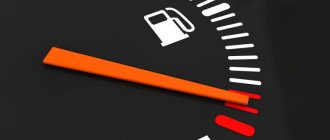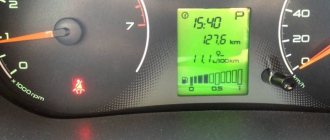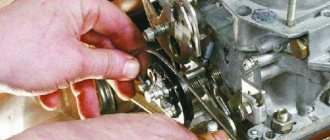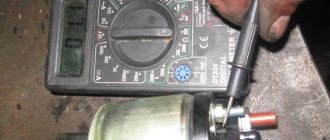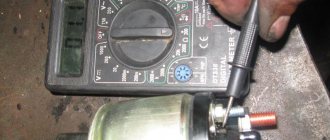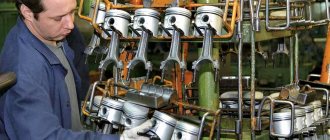10-14 6-9 VAZ
admin 09/13/2016
- VAZ-2109 1.1 carburetor Gasoline consumption VAZ-2109 1.1 carburetor per 100 km. Reviews
- Fuel consumption VAZ-2109 1.3 carburetor per 100 km. Reviews
- Fuel consumption rate VAZ-2109 1.5 carburetor per 100 km
- Reviews about fuel consumption of VAZ-2109 1.5 injector
- Real reviews about fuel consumption of VAZ-2109 1.6 injector per 100 km
The production of the five-door hatchback VAZ-2109 began in 1987, three years after the appearance of the three-door version of the VAZ-2108. These two cars became a completely unique phenomenon for the Soviet automobile industry - first of all, with their front-wheel drive layout, modern design at that time and an improved interior compared to previous Zhiguli models. The VAZ-2109 was more popular because the five-door design was more convenient than the three-door one.
The production of a car of this model continued until 2004 in the Russian Federation and until 2011 in Ukraine - here the VAZ-21093 version was assembled from vehicle kits supplied to the country by AvtoVAZ. Currently, this model is replaced in production by the VAZ-2114 model.
VAZ-2109 1.1 carburetor
The VAZ-21091 model was equipped with a derated carburetor four-cylinder VAZ-21081 engine with a volume of 1.1 liters. It developed a power of 54 hp. and a torque of 79 Nm at 3600 rpm. The engine was paired with a 4-speed manual transmission, but production of this model did not last long - until 1991, since the engine power was clearly not enough.
Gasoline consumption VAZ-2109 1.1 carburetor per 100 km. Reviews
- Yana, Odessa. My husband and I bought a VAZ-2109 with a 1.1 liter engine in 2013. At first we were surprised, we didn’t think there was such an engine, but it turned out that it was the original engine. The car was produced in 1990, but is in good condition and the engine is actually not as weak as it seems - there are four of us in the family plus a trailer - it drives fine. Consumption on the highway is about 5.5 liters, in the city – about 8.5 liters.
- Vladimir, Kozlovsk. The engine is not original - after mine burned out, I had to replace the engine. I couldn’t find a 1.5 liter one from my family, but through friends I managed to get a 1100 cm3 engine. What can I say about the dynamics - there is none at all, acceleration is generally slow, it does not accelerate more than 100 km/h at all. But in operation it is quiet and economical - 8 liters in the city, 5.5-6.0 liters on the highway.
Restyling
Most Russians prefer domestic cars to foreign cars, and most of the models were produced a long time ago.
Among modern cars - VAZ-2109. But the vehicle is both technically and morally outdated. Restyling will help give the car a second life.
Many people are interested in where to start. All Russian cars, regardless of the year of manufacture, have a common problem - the level of sound insulation.
This does not apply to those who like to drive slowly, but there are vehicles that accelerate to 90 km/h and above; you have to shout so that the passengers sitting behind can hear the driver.
Dashboard. The next level is advanced car restyling. In this case, the most dramatic changes to the car are coming.
VAZ-2109 1.3 carburetor
The base engine for the VAZ-2109 was the VAZ-2108 engine. This is an inline four-cylinder carburetor engine with a volume of 1289 cm3 and a power of 64 hp. and with a torque of 94 Nm. Initially, the engine was equipped with a 4-speed manual transmission, but later a more efficient 5-speed gearbox was installed for it. The model with this engine was in production until 1997.
Also produced in a small series was the VAZ-2109-91 model, equipped with a 1309 cm3 rotary piston engine. This engine developed a record 140 hp for that time. and a torque of 186 Nm, but it was too unreliable and whimsical, so production was curtailed in the early 1990s.
Fuel consumption VAZ-2109 1.3 carburetor per 100 km. Reviews
- Dmitry, Pavlodar. Before my “nine” I had a “kopeck”. After that I wanted to buy a foreign car, but for the amount I had, I could only buy a piece of shit that was trashed. I found a car made in 2000, with a 1.3 liter carburetor. What can I say - I started repairing it literally 30 minutes after purchase, because the battery died. On the highway the consumption is about 7 liters, in the city – at least 8.5-9.0 liters.
- Oleg, Novosibirsk. I bought a “nine” from a friend in 2011. She stood in the garage for almost three years, did not leave and did not start. He discounted it at a normal price, I took it for service and the master said that it was in export configuration - that’s why it was preserved in normal condition, even though it was manufactured in 1993. I did the repairs and after that it started working like clockwork. It starts with half a turn, consumption in the city is 7.5 liters, on the highway generally 5.5 liters. They’ve already offered to buy it more than once or twice, but for now I’ll go on my own.
- Mikhail, Khanty-Mansiysk. I bought the car back in 2006 – and it was hard to call it a car. The box was completely destroyed, the engine was generally in the trunk, I’m generally silent about the wiring and everything else. But the body was in excellent condition, only the wings were overcooked. I completely silenced it, gave the engine a major overhaul, and replaced the gearbox with a five-speed gearbox - by the way, a 5-speed manual transmission is completely useless for it, because... It still doesn’t go more than 130 km/h. But for the city it will do - consumption is about 8 liters, on the highway 6.5.
- Denis, Omby. VAZ-2109, engine 1.3 carburetor, 1994 The car was purchased in 2000, in 2005 I took it for myself after the death of my father. Of course, it has undergone a lot of repairs, but overall the car is not bad - it has soul. Gasoline consumption in the city is 10 liters, on the highway 7 liters, but I like to press on the gas - if I drove more calmly, then the consumption would of course be lower.
Other cars: Toyota Estima fuel consumption reviews
What reasons influence high fuel consumption?
Already experienced drivers can tell exactly why their car, for one reason or another, has high gas mileage. We would like to give you an example of several problems that the owner of a VAZ 21099 car may encounter:
- poor or incomplete opening of the carburetor damper;
- lack of oil in the gearbox - leads to a reduction in transmission;
- the ignition timing is poorly set - early or late ignition reduces power;
- the vacuum accumulator sensor is faulty;
- when a large amount of fuel enters the carburetor.
Such nuances should be taken into account if you decide to find the problem of high fuel use.
VAZ-2109 1.5 carburetor
In 1988, production of the VAZ-21093 model began, equipped with a VAZ-21083 four-cylinder carburetor engine. This engine developed a power of 68 hp. and at 3400 rpm it achieved a torque of 104 Nm. This model was in production until 2006, until it was completely replaced by versions with injection engines.
For the VAZ-21093, the engine was paired only with a 5-speed gearbox, which made it possible to achieve significant fuel savings, especially when driving outside the city.
Fuel consumption rate VAZ-2109 1.5 carburetor per 100 km
- Alexey, Barnaul. Before my “nine” with a 1.5 engine, I had the same one, but with a 1.3 liter engine. So, in terms of dynamics, the one and a half car is much more interesting, although the difference in power is only a couple of horses, but it turns much more fun. Well, in terms of consumption, the maximum I could get in the city was 10-11 liters in winter, but on the highway you can safely invest 6 liters.
- Ivan, Irkutsk. I took my “nine” in 2009. Why the “nine” - for my budget they decided to take it better than a foreign car that was trashed. She served me for about six years - after that my dear was so tired that she simply refused to ride. Well, this is not surprising, because the car is from 1996, and more than 10 years is a long time for our automobile industry. Although, in principle, the machine is unpretentious, and the average consumption was 8 liters - for a 1.5 liter carburetor this is not so much.
- Vladimir, Krasnoyarsk. The purchase of the VAZ-2109 was due to numerous advice in the style of “it’s better to buy a domestic car than an imported bucket of bolts for the same money.” I don’t know what the condition of the imported bucket is, but the belching of the domestic auto industry after a closer acquaintance (and I completely disassembled it) is terrible. The engine is mounted on one cushion, the whole body is rotten, the seats are different from each other - and that’s not all. The only plus is the consumption of 9 liters in the city.
- Denis, Novosibirsk. I drive a 1997 Nine. One of the last ones to be produced with a carburetor. I bought the car in 2013, with a mileage of almost 200 thousand km. Yes, it needs to be repaired - but this is done simply and without hemorrhoids, and spare parts cost 10 rubles a bucket, unlike foreign cars. Consumption on the highway is 7 liters, in the city from 9 to 11 liters - depending on how you load it.
- Arsen, Arzamas. My first car - I bought it for 90 thousand rubles in 2006. I drove it for 2 years, it started to rust and rot, half of the components fell off, even though the car was 1996. On the plus side, you can easily fill up with 92 gasoline, and consumption in the city is up to 10 liters.
- Anton, St. Petersburg. VAZ-21093, -1996, complete stuffing (wheels, high panel, heated seats, electric windows). At the time of purchase - and this was 2005 - it was cool! Compared to the “six”, the car is much better - the suspension is softer, the gears are longer and you can safely go 120 km/h on the highway. I used A-92 gasoline and drove without problems with a consumption of about 10-11 liters in St. Petersburg.
- Kirill, Barnaul. The first car, I repaired it a lot and for a long time - but this is probably how it should be, so after three years of ownership I began to quickly understand cars. In general, I’m happy with everything, the consumption is on average 8 liters per hundred square meters, and you can even pour A-80 without any problems if you’re really tight on money.
- Alexander, Feodosia. I bought the car from a guy who had it in his garage for 5 years. Despite the fact that the owner treated the car well, this is still a domestic auto industry. The interior is uncomfortable, everything creaks and cracks, the electrics constantly short out, the body probably begins to rot right as the car leaves the workshop. And the consumption is 9-10 liters on this trough, which practically does not move... In general, I drove it for a year and sold it to hell.
Other cars: Land Rover Discovery fuel consumption owner reviews
Table of fuel costs for VAZ brands.
The table describes the average costs for different VAZ brands
.
Fuel consumption is presented in three types - city, highway and mixed (average) fuel consumption. All data on fuel costs are from the VAZ car manufacturer. For almost all brands of VAZ cars, fuel consumption does not exceed 10 liters per 100 km, with the exception of the carburetor Niva.
| Brand VAZ | Power, hp | Average fuel consumption VAZ liter/100 km | City | Route |
| VAZ 2101 (1.2, carburetor) | — | 10.5 | 11 | 90 km/h=7.5 120 km/h=10 |
| VAZ 2102, 2103 (1.5, Carburetor) | 71 | 11 | 11.5 | 90 km/h=7.2 120 km/h=9.8 |
| 2106 (1.57 engine, carburetor, four-speed gearbox) | 76.4 | 9.5 | 10.5 | 8.5 |
| 2106 (1.45 engine, carburetor, four-speed gearbox) | 73.5 | 9.9 | 10.8 | 9.0 |
| 2106 (engine 1.6, injector) | — | 8.4 | 9.8 | 7 |
| 2105 (1.3, carburetor) | 64 | 9.1 | 10.2 | 8.1 |
| 2105 (1.5, carburetor, four-speed gearbox) | 71.1 | 8.8 | 9.5 | 8.0 |
| 2107 (1.6, injector) | — | 7.8-9.8 | 9-11.5 | 6.7-8.2 |
| 2107 (1.6, carburetor) | — | 8.9 | 10.2 | 7.5 |
| 2107 (1.5, carburetor) | — | 8.3 | 9.6 | 7.0 |
| 2108, 2109, 21099 (1.5, carburetor) | 72 | 9.1 | 10.1 | 8.2 |
| 21083, 21093, (1.5, injector) | 72 | 7.6 | 8.5 | 6.7 |
| 2110, 2111, 2112 (1.5, carburetor) | 67.7 | 9.5 | 10.5 | 8.4 |
| 2110, 2111, 21124 (1.5, injector) | 72 | 7.9 | 8.7 | 7.0 |
| 2113, 2114, 2115 (1.5, injector) | 72 | 7.6 | 8.5 | 6.7 |
| Lada Granta (8 valve) | 80 | 7.0 | 8.3 | 5.8 |
| Lada Granta (8 valve) | 90 | 7.7 | 9.3 | 6.1 |
| Lada Granta (16 valve) | 98, 106, 120 | 8.1-10.1 | 9.2-11.2 | 7-9 |
| Lada Kalina 21117, 21118, 21119 (1.4 engine) | — | 6.9 | 7.8 | 6.0 |
| Lada Kalina 21118, 21119 (engine 1.6) | — | 7.2 | 8.1 | 6.3 |
| Lada Priora (1.6) | 90 | 7.6 | 8.8 | 6.5 |
| Lada Priora (1.6, 16 valve) | 106 | 8.6 | 9.5 | 7.7 |
| Lada Vesta 21179 (1.8, 16 valve) | 123 | 8.5-10.5 | 9.5-11.5 | 7.5-9.5 |
| Lada Vesta 21129 (1.6, 16 valve) | 106 | 8-10 | 9.0-11.0 | 7.0-9.0 |
| Lada x-Ray (X-ray, 1.6, 16 valves) | 110 | 7.9 | 8.8 | 7.0 |
| Lada x-Ray (X-ray, 1.8, 16 valves) | 122 | 8.1 | 9.1 | 7.2 |
| Lada Largus (1.6, 8 valve) | 90 | 8.6 | 9.5 | 7.7 |
| Lada Largus (1.6, 16 valve) | 105 | 8.2 | 9.0 | 7.5 |
| VAZ 21213 (Niva, 1.7, carburetor) | — | 11.5 | 13.0 | 10.0 |
| VAZ 21214 (Niva, 1.7, injector) | — | 9.8 | 11.0 | 8.5 |
| VAZ 2131 (Niva, 1.8, injector) | — | 11.1 | 12.8 | 9.5 |
VAZ has acceptable fuel consumption!
The car is given good dynamics and acceptable fuel consumption thanks to its reliable engine.
VAZ has an affordable price for both a new and an old car. Old VAZ brands are acceptable to most people. The new VAZ engine demonstrates extreme efficiency, thanks to which the car has low fuel consumption and a reduced level of harmful emissions into the atmosphere.
VAZ - average quality cars, affordable price and acceptable fuel consumption.
What could cause increased consumption at VAZ?
1. Increased VAZ fuel consumption is observed in cars with worn out engines
. High piston wear will increase fuel consumption of any VAZ brand. Wear is determined by measuring compression in the VAZ engine block. If the compression is low, the piston needs to be replaced (rings, piston, block boring).
2. Temperature sensors influence the increased flow rate
coolant, throttle position, mass air flow and detonation.
3. High fuel consumption in VAZ cars is observed when the accelerator drive is faulty
, correct alignment settings, lowering tire pressure.
4. An increase in fuel consumption in VAZ cars with carburetor engines is observed when there is a problem with the carburetor
. These are holes in the diaphragms, incorrect adjustment of the choke cable, enlarged fuel jets, mixing up of air jets in two working chambers (chamber 1 = 165 mm, chamber 2 = 125 mm).
Timely completion of technical inspection will allow VAZ to maintain fuel consumption at the level declared by the manufacturer.
With fuel prices constantly rising, many motorists are interested in reducing fuel consumption. This is especially true for owners of domestic cars who cannot boast of efficiency. Therefore, we have prepared an article on how to reduce consumption on a carburetor VAZ 2109, but it will also be useful to owners of other cars, including foreign cars.
VAZ-2109 1.5 injector
Since 1998, serial production of the VAZ-21093i model began, equipped with a VAZ-2111-80 injection four-cylinder engine with a power of 74 hp. and with a torque of 118 Nm. Compared to carburetor engines, injection engines not only developed higher power and torque, but also had better elasticity at low speeds and were more economical. These engines were also offered with a 5-speed manual transmission.
Reviews about fuel consumption of VAZ-2109 1.5 injector
- Alexey, Tomsk. I wanted a car since I was 18 years old, but naturally there was simply no money for it. Then the car appeared, but another problem arose - I needed a working car, so that killing would not be a pity and would be inexpensive at the same time. I decided to take the injection “nine” 2002. Her condition was more or less - well, what condition can a ten-year-old VAZ have? In principle, it justified itself - spare parts are inexpensive, you don’t mind killing it, and gasoline consumption is 10 liters per 100 km in the city, an injector after all.
- Alexander, Barnaul. VAZ-21093, 2002, 1.5 injector. Purchased with a mileage of 120 thousand km. Everything that could possibly creak in it creaked, and probably even more. There were a lot of mistakes, everything had to be done constantly, but for the money that I paid, I shouldn’t have expected anything else. But low fuel consumption - up to 8 in the city and up to 7 on the highway, as well as the ease of repair and low cost of spare parts compensate for many shortcomings.
- Kirill, Abakan. I bought a “nine” in 2014. The car was produced in 2003, with a one and a half liter injection engine. I bought it when I was a student - what else did I need? The condition is normal, the owner himself admitted that one wing was broken, but it was made very well. At the same time, the luxury package is another plus. Well, efficiency - in winter the maximum reaches 11 liters, in summer about 9, on the highway it depends on the speed - from 6 to 7 liters.
- Denis, Yekaterinburg. I learned to drive in my father’s service VAZ-2109, with a carburetor. In my second year at university, I managed to save some money and buy my own “nine”, but I bought it with an injector - it’s faster than with a carb, and its consumption is lower. In the city I drove consistently 50-70 km/h, consumption was up to 8.5 liters per 100 km, on the highway - no more than 120 km/h, consumption was accordingly about 7 liters.
- Vasily, Ufa. In general, I have a Toyota Corona, but I drive a VAZ-2109 in my free time. I actually bought it by accident - at a gas station I saw a car with an advertisement on the rear window, talked to the owner and bought it. She was in good condition, the car was well maintained, the engine was tuned for maximum efficiency. Believe it or not, in the city 10 liters is enough for me for 130 km, i.e. consumption is around 6.5-7.0 liters per 100 km.
- Grigory, Sergiev Posad. VAZ-21093i, 2001. When purchasing, the budget was 100 thousand rubles - not much, but true. Naturally, I chose only the domestic auto industry, I didn’t even look at foreign cars. In principle, “nine” is the cheapest and most practical option. Yes, you have to tinker with it, but the spare parts are inexpensive, repairs are also simple and can be done in the garage, and the fuel consumption of 8 liters in the city is quite low and no worse than that of many foreign cars.
- Pavel, Moscow. "Nine" 1999. My faithful student car, in which I honestly drove throughout my studies at the university, transported a bunch of girls and my future wife. What else does a student need - consumption in Moscow is a maximum of 10 liters with traffic jams, comfort is not so great, but it is there, spare parts are cheap and you can easily repair it on your own with your dad and you.
Other cars: Peugeot 408 fuel consumption
Common problems with high fuel consumption
There are factors for increased fuel consumption that are common to both the injector and the carburetor. Let's look at them in more detail:
1. Failure of the catalyst, surprisingly, can lead to increased consumption. And the pattern here is very simple: “the more clogged the catalyst is, the richer the mixture enters the combustion chamber.” What is the result of all this is not difficult to guess.
2. Cold engine
It is important to remember that the temperature norm is in the range of 98-103 degrees Celsius. Anything more is already bad
Antifreeze boils at 110 degrees.
When the engine is overheated, the air-fuel mixture is too thin. As a result, the mixture is too lean and the power unit loses power.
If the engine has not warmed up, then everything happens the other way around - the “gluttony” of the car increases.
For example, at an engine temperature of 75-80 degrees, the car will consume 15-20% more gasoline. In this case, the problem often has to be looked for in the thermostat.
3. Dirty air filter. It would seem like an insignificant detail - a dirty filter. In fact, due to “air starvation,” the engine is forced to throw more fuel into the combustion chamber. In modern cars, the mass air flow sensor may fail.
Of course, we have not analyzed all the reasons for the increased “appetite” of modern cars – only the main ones. But even this is enough to understand one important thing - consumption depends on the technical condition of the car, and therefore on you. Good luck on the roads and of course no breakdowns.
VAZ-2109 1.6 injector
In 2001, the VAZ-210934-20 model appeared. As a power unit, it uses an injection four-cylinder 8-valve VAZ-11183-20 engine with a volume of 1596 cm3. It produces 81 hp. and a torque of 120 Nm and is combined with a 5-speed manual transmission.
Real reviews about fuel consumption of VAZ-2109 1.6 injector per 100 km
- Evgeniy, Ekaterinburg. I’ll say right away that I bought the car to drive. There is nothing native left in her anymore. The engine is 1.6 liters and that friend rebuilt and rebuilt it for me, it now produces more than 100 horses. Consumption, of course, has also increased - in the city it’s about 14 liters, if you drive calmly it’s about 10 liters. But I like it and do everything at the traffic light.
- Ilya, Samara. After I got my license in 2005, I had exclusively domestic cars for almost 8 years. The latest from our automobile industry is VAZ-210934-20, with a 1.6 liter injection engine. The car was produced in 2001, it has covered 150 thousand in 10 years. After the purchase, the engine, suspension and everything else were overhauled - the rest did not cause problems. I’ll tell you, the car is reliable and unpretentious, if you look after it, and it’s also economical - in the city it’s never been more than 9 liters, on the highway it’s about 5 liters in general.
- Denis, Anzhero-Sudzhensk. I bought a car from my father - he still saved up the money to switch to a foreign car, but I got my own car. Its main feature is the engine, 1600 cubes. Consumption in the city is about 10 liters, well, for any car with such an engine it is almost identical. I drove it for a year and a half and decided that it was expensive to refuel with gasoline - I installed an LPG system. Consumption has increased, but this is also because I stopped saving - now in the city I have a stable 12-13 liters, but given the price of gas, this doesn’t bother me at all.
- Kirill, Barnaul. I don’t care about those who criticize the domestic auto industry. Yes, it may be inferior in quality and reliability to foreign cars, but it is also much cheaper to buy and to operate. And if your arms are straight, then everything will be fine. I bought it with a mileage of 150 thousand - I only replaced the chassis, pump and cooling fan. The timing belt was changed at 175,000 km!!! The 1.6 liter engine performs very well, the brain did not float at all. And also economical - in mixed mode it never produced more than 7.5 liters.
- Timofey, Sergiev Posad. "Nine" with a 1.6 liter injector, 2003. Before it there was a “five” - when I changed, it seemed like I was driving a foreign car. Consumption up to 12 in the city and 7 on the highway, I adjusted everything to suit myself - in general, it didn’t bother me at all for 3 years (although I still did minor repairs). Now I’m thinking of selling and buying a Skoda.
- Vasily, Krasnoozerskoe. VAZ is a VAZ. You always know what to expect from him, you know that even with serious repairs you will be able to support him financially. And it carries its rear just like a foreign car. The downside is the constant noise in the cabin, everything creaks and rattles. Consumption on the highway is about 7.5 liters, in the city 10 liters.
Setting up Solex
Many drivers strive to install a Solex-type carburetor on their car, since at the moment this carburetor is considered one of the best. It works great in any conditions, even with severe overflow. Many people mistakenly believe that the most difficult thing in this situation is installing a carburetor, but in fact, setting it up and adjusting it is also often difficult.
Some people prefer to delegate the work of installing or adjusting carburetors to specially trained people, however, most motorists strive to do all possible work themselves and have a great interest in this.
The procedure for setting up the carburetor is as follows:
We set the level in the float chambers. As a rule, in the manual the level is set using special floats using a special template. This is not an easy method unless there is a special factory setting. If there is no factory setting, you need to do it yourself. To do this, you need to start the engine and give it a few minutes to warm up. Then turn off the engine and remove the fuel hose
This must be done carefully, as a lot of gasoline will pour out of the hose. If gasoline flows into the chamber under pressure, the readings will be blurred
Now unscrew the carburetor cap and remove the choke cable. Carefully, horizontally, lift the carburetor cover. Otherwise the floats will be damaged. It is necessary to measure the distance from the surface of the gasoline to the lid of the Solex itself. You need to measure in each chamber, since the level in them is not the same, which means the distance will be different. The norm is 25-35 mm. For calculations, you should take the average value of the two cameras. If the level is lower or higher than normal, you need to bend the float in the right direction and drain some of the gasoline. An important point is that you cannot adjust the gasoline level without starting the engine, since if it is running, you will end up with an overflow of gasoline. The second stage of tuning is setting the engine idle speed. To do this, it is recommended to warm up the engine to normal temperature. After this, the engine is turned off and tuning begins. Now, using a screwdriver, you need to find the mixture quality screw in the hole in the carburetor sole; this screw should be turned to the right until it stops, but without using force. After this, you should carefully start the engine and remove the choke. Using a screw, the permissible minimum number of revolutions is set. It must ensure constant, stable operation of the engine and at the same time its discharge must be minimal. The normal number of revolutions is 500 - 1200, in this case we can say for sure that the carburetor is in order. We tighten the quality screw until the engine starts to run unstably. Then we return it to normal operation by turning it 1-2 turns back. Now you need to set the speed, the optimal value is 800-900 revolutions, but this number should be adjusted individually. The screw is turned until the optimal ratio is reached. Some difficulties may arise when adjusting the idle speed. It often happens that when the quality screw is rotated, the engine does not respond to it. Normally it should work unstable, you can adjust it with a screw. If this does not happen, it means gasoline is getting into the idle channel and the screw cannot close it. The reason for this situation may be that the jet is too large, if the plug is not screwed in properly, or if the jet itself is deformed. Diagnosis of the problem can be carried out as follows: remove the valve with the engine idling. In this case, the engine should stall. If the engine turns off, the problem is in the large jet. If not, it means the gasoline is flowing past the nozzle. In this case, you need to check the locking screw of the second chamber, which ensures smooth opening of the throttle valve.
Reasons for increased costs
There are a number of factors that determine the fuel consumption of a UAZ. They can be divided into three groups, among which are those that depend on the owner himself, the faulty technical condition of the parts or the type of flammable liquid. The influence of the last factor has already been mentioned, so we will focus on others.
The car is not working properly
The average gasoline consumption of the VAZ 2109 per 100 km is significantly influenced by the factors of incorrect carburetor settings, stuck needle and fuel pump (increase by an average of 4 liters). An insufficiently warmed up engine increases consumption by another one and a half liters.
Driving method of VAZ owner
The fuel consumption of 2109 per 100 km is also affected by the owner’s driving style - the higher the speed of the SUV, the greater the volume of liquid leaving the tank. When you turn on the headlights, the overall consumption rate increases by 10 percent, and flat VAZ tires have the same effect.
When installing a trailer, gasoline consumption increases by another 60 percent.
Data sheet consumption values for modifications 2109
During the production history of the Lada Nine, it was produced with five types of eight-valve engines, which differ slightly in terms of fuel consumption. Below are the engine models and their rated values for gasoline consumption per 100 km on a combined cycle.
Injection engines straight from the VAZ 2109 factory have higher fuel consumption than carburetor engines. But during operation, the fuel consumption of an injection engine does not increase as much as that of a carburetor engine, so we will not consider the fuel consumption of the VAZ 2109 injector in detail. Let us dwell on the reasons that often cause increased fuel consumption on modifications of the Lada Samara with a carburetor.
With timely troubleshooting of problems that affect overconsumption and proper driving of the car, you can achieve optimal gasoline costs.
